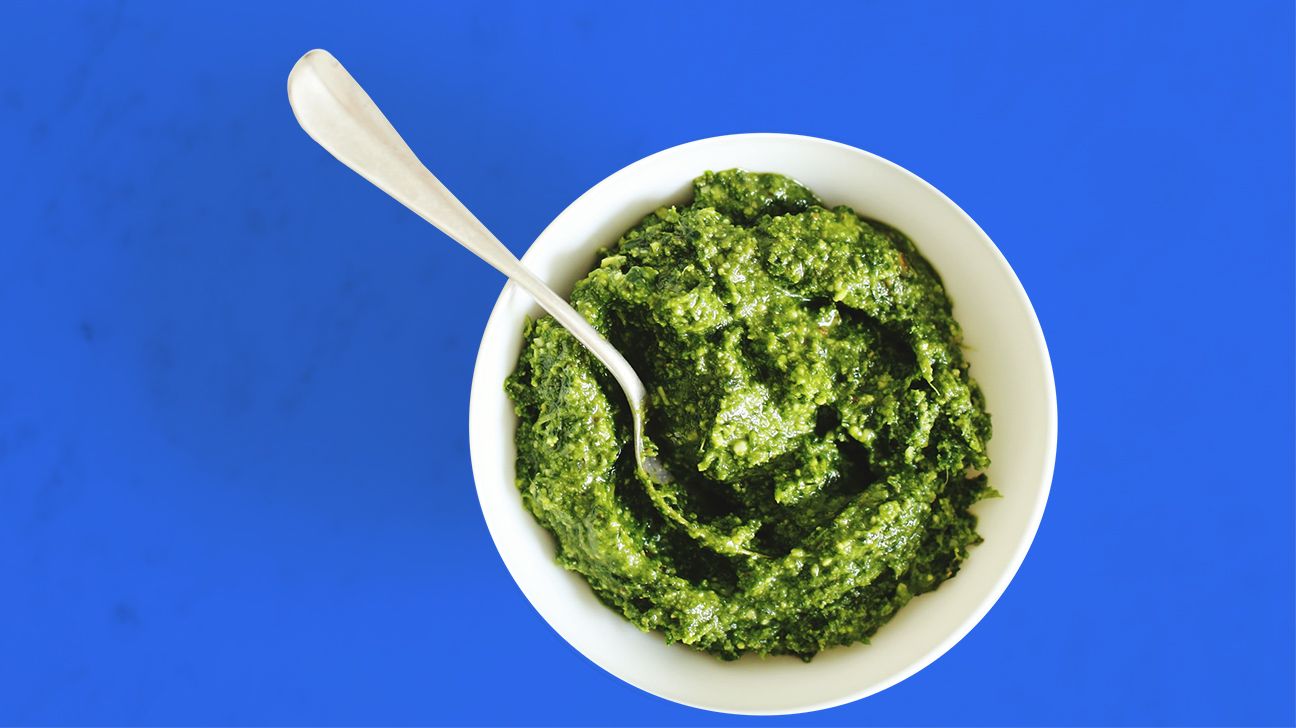
Pesto and chimichurri are both herby, green sauces with a fair amount of olive oil — but they’re not as similar in flavor as they might appear. So how exactly are they different?
Taken at face value, these two could practically be twins. (In fact, with just a visual test, you might not be able to tell which is which.) Both recipes call for fresh herbs, olive oil, and garlic — yielding a bright green color to rival a leprechaun’s britches.
Pesto and chimichurri can both be made in the food processor or blender, and both are excellent either as a dipping sauce or for slathering on your favorite chicken, fish, steak, or veggies. So yeah… you could say they’ve got a lot in common.
Then again, the two sauces are more fraternal than identical twins.
For one (big) thing, the herbs that give each of these sauces their shamrock-green color are different. Pesto, which traces its roots back to Genoa, the capital city of Italy’s Liguria region, is made with basil.
Chimichurri, meanwhile, is of Argentine descent, and is typically a blend of parsley and oregano. Cilantro often gets in on the fun too.
Both include garlic, but as for the liquid that gives them their saucy texture, there’s a bit of separation between the oil and vinegar — literally.
Pesto calls on olive oil to bind together its classic combo of basil, garlic, parmesan and pecorino cheeses, and pine nuts. Chimichurri also uses a little oil (either vegetable or olive), but, crucially, adds in white vinegar to give the sauce its signature puckery tang.
Both are easy to riff on (pesto in particular is often modified to sub in greens like kale and arugula or swap walnuts for pine nuts) and play nicely in a wide range of recipes.
Here are some of our favorite ways to use these two like-minded sauces, from the traditional (think: chimichurri and grilled meat; pesto and pasta) to the more creative (no spoilers, keep reading).
1. Easy chimichurri sauce
We couldn’t start without this vid that shows you the basics of chimichurri. The bright, textured parsley- and oregano-based sauce is the perfect partner to grilled steak or chicken, both of which can be repurposed the next day in tacos.
If meat isn’t your jam, this versatile salsa is also pretty sensational with grilled seafood (try thicker cuts like salmon or swordfish, or juicy jumbo shrimp) or on grillable veggies like corn on the cob.
Most often, the sandwich side of the love affair between beef and chimichurri results in a lot of steak sandwiches. No hate, of course, but how dare we overlook the OG of beef sandwiches, the burger?
This drool-worthy rendition features a double patty design that’s bound together with a chimichurri compound butter that oozes out as it cooks.
Think “chimichurri” and “breakfast” and your brain might immediately turn to tacos — but as this recipe proves, it’s not the sauce’s only morning meal application.
Here, the herb-driven sauce is mixed with savory mushrooms and hearty kale to create good-for-you base for runny-yolk baked eggs. This has “Impressive Brunch Menu” written all over it.
Well, whaddya know, chimichurri is as good on carbs as it is on protein (actually not surprising given that it’s classic pairing with empanadas). Instead of using the sauce for dipping, the tangy-fresh mixture is drizzled over the top of homemade fries alongside crumbled gorgonzola.
The chimichurri in this quick chicken salad swaps the traditional oregano for cool mint, which works especially nicely with the pieces of juicy, sweet peach.
You can experiment with pesto, but you might want to start with a classic basil version and expand from there.
It may not have the A-list celebrity status of marinara, but pesto is still one of the most iconic Italian sauces. A delightfully simple combination of fresh basil, garlic, olive oil, pine nuts, and Parmesan, it’s got that little-black-dress quality that allows it to go with just about anything.
Tossed with pasta, slathered on pizza, schmeared on toast, mixed in with soup or rice or even eggs — the possibilities are endless. Guess it is easy being green.
Pasta is pesto’s most frequent culinary companion, and this recipe is a versatile starter for pairing the two made-for-each-other components. Add different veggies if you like, or give it some oomph with a protein like diced chicken or canned chickpeas. And, of course, we won’t tell if you sprinkle on some extra parm.
Vibrant pesto replaces the typical tomato sauce in this light, healthy summer pie featuring sliced seasonal squash, red onion, and fresh mozzarella.
The gauntlet has been thrown, ladies and gentlemen. This is what it looks like when your brunch dish game is on point: Savory, fluffy dutch baby base, bold pesto, torn pieces of salty prosciutto, creamy burrata, crisp strips of shaved asparagus, and baked eggs. Boom.
The classic Italian rice dish is reimagined in this recipe with a non-traditional pesto that adds walnuts, kale, chives, and parsley to the typical basil-parm-garlic base. And of course chopped pieces of crisp, salty, fatty bacon are mixed in, because why not?
Between pesto and chimichurri, there’s certainly not a bad choice for your meats, seafoods, and sandwiches. It all depends on whether you feel like layering your meals with some Italian gusto or some Argentine sabor. Either way, you’ll get a green sauce that elevates mealtimes in just moments.
